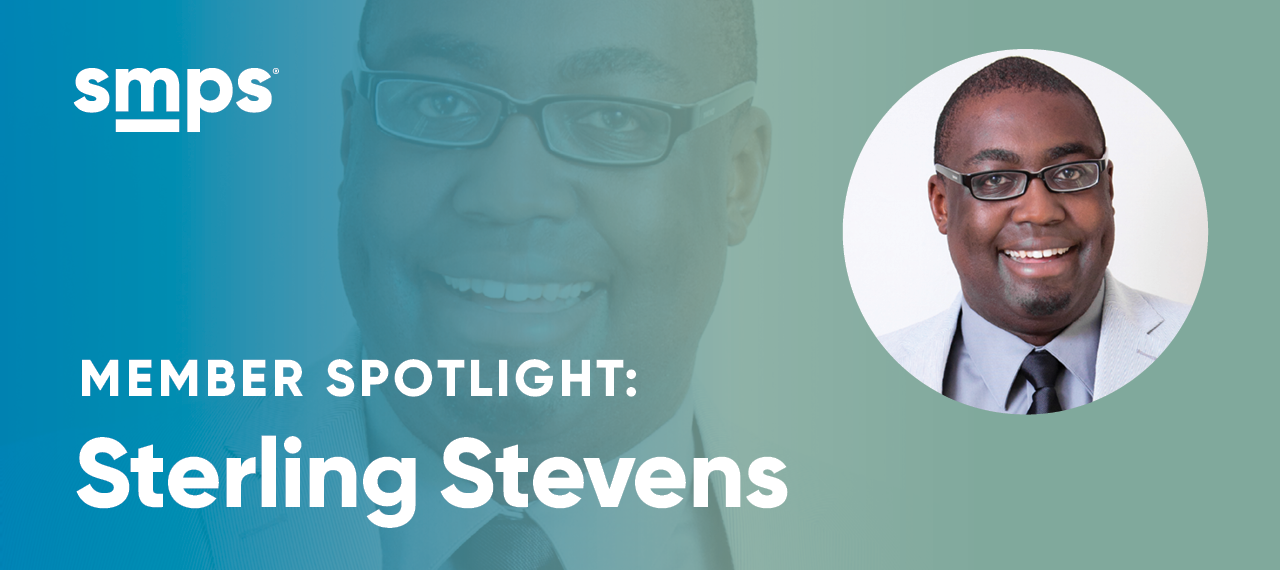
In our member spotlight, Sterling Stevens sits down for a virtual chat with SMPS. Sterling is an architectural photographer and owner of Sterling E. Stevens Design Photo. He has been in the A/E/C industries for 25 years and an SMPS member for six. In this spotlight, Sterling shares the rewards of his career and the best advice given and received.
What’s your favorite part of the job? That I get to blend two things I treasure most (art and design) on a daily basis. Since childhood I’ve been a keen observer of my surroundings, which influenced my passions for both architecture and photography. The challenge of visually translating the intent, impact, and craft of built design in an understandable way keeps my mind active and engaged.
What have been the rewards of your career? Having a career in the A/E/C is often a roller coaster. As an employee somewhere on the corporate ladder, contacts I never negotiated influenced projects I managed across every task, from design latitude to client relations to quality control. Becoming the face of my own business allowed me to assume greater control over decision-making and career direction. I get to run the show from top to bottom, interfacing exactly how I believe it should. Working for myself has been the most steady and satisfying job I’ve ever had.
What are some of the challenges? Having spoken with several other architectural photographers, it can be an isolating career that isn’t conducive to a steady work-life balance. Many in this profession spend a lot of time away from family and loved ones, and I’ve made many personal sacrifices just to pursue this. As much as I love the work, it’s a true grind. Another challenge is simply the vulnerability of being a creative professional. Successful pursuit in these fields requires an intense, personal investment into your work and collaborating with wide spectrum of personalities and egos that also place their heart into everything they do. There are inherently emotional highs and lows inextricably tied to continually diving into the deep end.
What has been your most meaningful project? Collaborating with Clearscapes to capture the Chavis Community Center in Raleigh, NC, which carries historical importance especially to the local Black community. The motivation behind my design career stems from my childhood, with lifelong sensitivity towards blending improvements into the urban fabric while retaining the integrity of local communities. The focus of my university studies lent itself towards civic impact and community collaboration and participation, which influenced my thesis as a fine art photographer.
While on location, my camera was set up on 10-foot tall tripod alongside a ladder when a Black, preteen boy passing by paused to give me a slightly quizzed look, followed by a brief conversation:
Kid: “Excuse me, what are you taking pictures of?”
Me: (gesturing ahead) The building.
Kid: For what? The park?
Me: No, the architect who designed the community center.
Kid: Oh! (pause) I didn’t know you could do that. That’s cool!
My career has been a bumpy road and that simple moment felt like 30 years of hard work had finally come full circle, enveloping everything I passionately value about design, diversity, and democratization of our built environment.
What’s the best advice you’ve received regarding your career? If there’s any insight to what sort of child I was, my goal by age 5 was to know everything about everything. I’ve always had my hands in many different pools of interest and my college years offered a productive environment to learn and explore. While studying and practicing architecture, I picked up extensive experience in graphic design, website development, published essay writing, and photography. I also took extra time to study economics, business law, and accounting. When branching out to establish my own business I attempted to sell all those talents under the same umbrella. During a speed networking event, I was explaining what I could do and one of the professionals paused my rambling and advised, “Whoa, whoa, whoa. That’s great you can do all this random stuff, but what is it that you actually do? You need to simplify and decide what that is.”
That advice saved my professional life and moving forward, I exclusively focused on architectural photography. It’s the first time I’ve ever put all my eggs in one basket and my career immediately skyrocketed after rebranding. Today, I use my library of knowledge and diversify of capabilities to support a single clear endeavor.
What’s the best advice you’ve given? Not every opportunity is a good one.
Why is membership in SMPS important to you and how has it helped you and your firm? This is more a personal answer than purely professional. My first experiences with SMPS were often uncomfortable and after an unpleasant experience, I silently left the organization. When SMPS HQ learned of my departure, their leadership reached out and we had a sincere and genuine discussion, which convinced me to renew. Upon returning to SMPS with a new chapter, my experiences have been very positive. This is a great example of why difficult, yet crucial conversations need to happen. The health of any organization depends on seeing, hearing, and understanding its members. When people make proactive efforts to communicate and genuinely listen, it can broaden perspectives, influence choices, and help shape an individual’s personal and professional growth. Today, I’m happy to contribute to SMPS where possible.
Guilty pleasure: What can you not live without? Music. All day, every day.
Response from SMPS Chief Executive Officer Michael V. Geary, CAE:
Thank you, Sterling, for sharing your story. Having candid conversations is critical and, at the same time, I recognize it’s not easy for everyone. I’m glad you took the time to speak with us about your experience and that you gave SMPS a second chance. As a people-first organization, we want to be a space where members feel comfortable talking, and a community where they feel like they belong. If there’s anything else you’d like to share, please reach out to me personally at michael@smps.org to continue the conversation, and that goes for anyone reading this. Thank you for being a part of the Society. ~SMPS CEO Michael V. Geary, CAE







